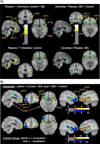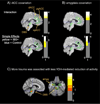Evidence for alterations in central noradrenergic signaling in irritable bowel syndrome
- PMID: 22917679
- PMCID: PMC4130741
- DOI: 10.1016/j.neuroimage.2012.08.028
Evidence for alterations in central noradrenergic signaling in irritable bowel syndrome
Abstract
Background/aims: Alterations in noradrenergic (NE) signaling have been implicated in the pathophysiology of irritable bowel syndrome (IBS), and adrenergic receptors are potential treatment targets.
Methods: To characterize central NE signaling in IBS, 11 patients and 11 healthy controls (HCs) were studied 3 times during an auditory oddball vigilance task after double-blind ingestion of the α2-adrenoreceptor (α2AR) antagonist yohimbine (YOH), the α2AR agonist clonidine (CLO), or placebo (PLA). Regional cerebral glucose metabolism was measured with [¹⁸F] fluorodeoxyglucose (FDG) positron emission tomography (PET). Measures of anxiety, early-life trauma, plasma NE and blood pressure were acquired.
Results: Patients had higher plasma NE levels than HCs before and after ingestion of all drugs (all p<0.05). YOH increased plasma NE and more anxiety in patients than in HCs. After YOH, NE levels directly correlated with drug-induced increases in anxiety in IBS patients (r=0.61), but not in HCs. IBS patients showed less YOH-mediated reduction of activity in a central arousal circuit, consistent with fewer functional presynaptic α2AR. In HCs, but not in patients, activation of amygdala and subgenual anterior cingulate cortex (sgACC) was inversely correlated with activation of anterior mid cingulate cortex (aMCC), and state anxiety covaried directly with activity in limbic and right frontotemporal cortices, but indirectly with activity in the left frontotemporal cortex. YOH-mediated reduction of activity in brainstem and amygdala inversely correlated with early life trauma.
Conclusions: IBS patients showed evidence for increased noradrenergic activity consistent with downregulation of presynaptic inhibitory α2ARs. Activity within central arousal circuits was biased toward greater excitability and reduced corticolimbic inhibition in IBS. Early life trauma may be one mediator of these abnormalities.
Copyright © 2012 Elsevier Inc. All rights reserved.
Conflict of interest statement
Disclosures: No conflicts of interest exist.
Figures




References
-
- Adeyemi EO, Desai KD, Towsey M, Ghista D. Characterization of autonomic dysfunction in patients with irritable bowel syndrome by means of heart rate variability studies. Am. J. Gastroenterol. 1999;94:816–823. - PubMed
-
- Aggarwal A, Cutts TF, Abell TL, Cardoso S, Familoni B, Bremer J, Karas J. Predominant symptoms in irritable bowel syndrome correlate with specific autonomic nervous system abnormalities. Gastroenterology. 1994;106:945–950. - PubMed
-
- Al-Chaer ED, Weaver SA. Early life trauma and chronic pain. In: Mayer EA, Bushnell MC, editors. Functional Pain Syndromes: Presentation and Pathophysiology. Seattle: IASP Press; 2009. pp. 423–452.
-
- Arnsten AFT, Goldmanrakic PS. Selective prefrontal cortical projections to the region of the locus coeruleus and raphe nuclei in the rhesus-monkey. Brain Res. 1984;106:9–18. - PubMed
-
- Berman SM, Chang L, Suyenobu B, Derbyshire SW, Stains J, FitzGerald L, Mandelkern M, Hamm L, Vogt B, Naliboff BD, Mayer EA. Condition-specific deactivation of brain regions by 5-HT3 receptor antagonist alosetron. Gastroenterology. 2002a;123:969–977. - PubMed
MeSH terms
Substances
Grants and funding
LinkOut - more resources
Full Text Sources

